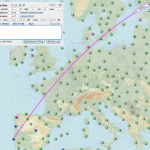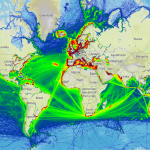Artificial Intelligence
Laboratory
Department of Digital Systems
University of Piraeus
Human-Centric AI
Our work focuses on developing, evaluating, and validating novel DRL and IRL methods that allow intelligent agents to perform tasks in collaboration with humans, aligning with human preferences and objectives, also with respect to constraints, promoting AI trustworthiness, safety and humans’ situation-awareness in jointly performing …
Read More
Read More
Modelling Complex Systems for Decision Making
Modelling (complex) systems for decision making using multi-agent reinforcement learning methods (MARL) for the computation of agents’ joint policies for action in critical domains is a priority and challenge here. Specifically, we aim to resolve cases in large-scale and complex settings where agents have conflicting …
Read More
Read More
Multi-Agent Agreements
The computation of agreements – or conventions- in agents’ societies via social learning methods, when agents aim to perform tasks in coordination with others is a challenge, especially when agents have to achieve multiple and conflicting goals simultaneously w.r.t. operational constraints, jointly with their peers, …
Read More
Read More
Ontology Alignment and Semantic Integration
Rich and diverse information sources of static or stream structured data do exist. However these are heterogeneous in various aspects: On the ways information is formed, on the ways information is described and shaped, on the ways different aspects of (abstract or concrete) entities are …
Read More
Read More
Knowledge Representation and Reasoning with Ontologies
Combining ontologies by discovering semantic associations at any level of abstraction, or decomposing large ontologies in modules w.r.t. logical properties either for re-usability of specifications, efficiency in ontology management, or efficiecy in reasoning, are goals that we need to pursue, especially when we deal with …
Read More
Read More
Exploratory, problem-driven research
 INUUSE: Deep Reinforcement Learning for Recommenders – The goal of INUUSE is to incentivize users to be engaged in interaction with items using a platform, eventually increasing their true reward and with incentives for expected utility. To reach this objective the project will investigate the use of deep reinforcement learning methods exploiting historical users’ trajectories towards learning… Read more…
INUUSE: Deep Reinforcement Learning for Recommenders – The goal of INUUSE is to incentivize users to be engaged in interaction with items using a platform, eventually increasing their true reward and with incentives for expected utility. To reach this objective the project will investigate the use of deep reinforcement learning methods exploiting historical users’ trajectories towards learning… Read more… CARE: Constraints-Abiding Explainable Reinforcement Learning – CARE aims to devise inherently interpretable safe RL methods providing transparency with regard to operational constraints. The main activities, include: – Study symbolic representations for constrained RL policy models. – Design, implement and validate an interpretable safe RL-based solution in constrained settings. CARE is an ENFIELD Exchange Scheme project on… Read more…
CARE: Constraints-Abiding Explainable Reinforcement Learning – CARE aims to devise inherently interpretable safe RL methods providing transparency with regard to operational constraints. The main activities, include: – Study symbolic representations for constrained RL policy models. – Design, implement and validate an interpretable safe RL-based solution in constrained settings. CARE is an ENFIELD Exchange Scheme project on… Read more… DeepHAC: Advancing Human-Agent Collaboration – The overall goal of DeepHAC is to advance Human-Agents Collaboration (HAC) building explainable DRL methods that enable agents to perform tasks in collaboration with humans with respect to human preferences, constraints and objectives, promoting safety and efficacy in performing collaborative tasks. The approach proposed by DeepHAC relies on three main… Read more…
DeepHAC: Advancing Human-Agent Collaboration – The overall goal of DeepHAC is to advance Human-Agents Collaboration (HAC) building explainable DRL methods that enable agents to perform tasks in collaboration with humans with respect to human preferences, constraints and objectives, promoting safety and efficacy in performing collaborative tasks. The approach proposed by DeepHAC relies on three main… Read more… SIMBAD: Combining Simulation Models and Big Data Analytics for ATM Performance Analysis – The goal of SIMBAD is to develop and evaluate a set of machine learning approaches aimed at providing state‑of-the-art ATM microsimulation models with the level of reliability, tractability and interpretability required to effectively support performance evaluation at network level. The project will focus on three fundamental problems: (i) how to… Read more…
SIMBAD: Combining Simulation Models and Big Data Analytics for ATM Performance Analysis – The goal of SIMBAD is to develop and evaluate a set of machine learning approaches aimed at providing state‑of-the-art ATM microsimulation models with the level of reliability, tractability and interpretability required to effectively support performance evaluation at network level. The project will focus on three fundamental problems: (i) how to… Read more… TAPAS: Towards an Automated and exPlainable ATM System – TAPAS (Towards an Automated and exPlainable ATM System) addresses explicitly the effectiveness of introducing AI/ML solutions in order to increase the levels of automation in ATM, considering the need of the operator to trust the system (taken as the ability to understand and explain its behaviour and outcomes). TAPAS will… Read more…
TAPAS: Towards an Automated and exPlainable ATM System – TAPAS (Towards an Automated and exPlainable ATM System) addresses explicitly the effectiveness of introducing AI/ML solutions in order to increase the levels of automation in ATM, considering the need of the operator to trust the system (taken as the ability to understand and explain its behaviour and outcomes). TAPAS will… Read more… Trajectory Planning for Conflict-free Trajectories: A Multi Agent Reinforcement Learning Approach – While data-driven methods aim to build models for trajectory planning and conflicts resolution, incorporating stakeholders’ interests and preferences, the multi-agent reinforcement learning (MARL) approach aims to address complexity phenomena due to traffic and resolve conflicts between multiple trajectories, simultaneously. Towards that goal we aim to formulate the problem as a… Read more…
Trajectory Planning for Conflict-free Trajectories: A Multi Agent Reinforcement Learning Approach – While data-driven methods aim to build models for trajectory planning and conflicts resolution, incorporating stakeholders’ interests and preferences, the multi-agent reinforcement learning (MARL) approach aims to address complexity phenomena due to traffic and resolve conflicts between multiple trajectories, simultaneously. Towards that goal we aim to formulate the problem as a… Read more… Data-Driven Trajectory Imitation with Reinforcement Learning. – Reinforcement Learning, and particularly Q-learning has been studied in the context of predicting trajectories, exploiting historical data about trajectories, enhanced with aircraft intent information . This is a recently-proposed approach whose potential and limitations have been explored by the DART project . However, exploiting aircraft intent has two major shortcomings:… Read more…
Data-Driven Trajectory Imitation with Reinforcement Learning. – Reinforcement Learning, and particularly Q-learning has been studied in the context of predicting trajectories, exploiting historical data about trajectories, enhanced with aircraft intent information . This is a recently-proposed approach whose potential and limitations have been explored by the DART project . However, exploiting aircraft intent has two major shortcomings:… Read more… datAcron: Big Data Analytics for Time Critical Mobility Forecasting – datAcron project is funded by the European Union’s Horizon 2020 Programme under grant agreement No. 687591.datAcron is a research and innovation collaborative project targeting at introducing novel methods to detect threats and abnormal activity of very large numbers of moving entities in large geographic areas. Towards this target, aims to… Read more…
datAcron: Big Data Analytics for Time Critical Mobility Forecasting – datAcron project is funded by the European Union’s Horizon 2020 Programme under grant agreement No. 687591.datAcron is a research and innovation collaborative project targeting at introducing novel methods to detect threats and abnormal activity of very large numbers of moving entities in large geographic areas. Towards this target, aims to… Read more… DART – Data-Driven Aircraft Trajectory Prediction Research – DART (Data-driven AiRcraft Trajectory prediction research) addresses the topic “ER-02-2015 – Data Science in ATM” exploring the applicability of data science and complexity science techniques to the ATM domain. DART delivers an understanding on the suitability of applying big data and agent –based modelling techniques for predicting aircraft trajectories based… Read more…
DART – Data-Driven Aircraft Trajectory Prediction Research – DART (Data-driven AiRcraft Trajectory prediction research) addresses the topic “ER-02-2015 – Data Science in ATM” exploring the applicability of data science and complexity science techniques to the ATM domain. DART delivers an understanding on the suitability of applying big data and agent –based modelling techniques for predicting aircraft trajectories based… Read more…
Latest News and Events
Young Scientist Award
Our George Papadopoulos received the 3rd Young Scientist Award @SESAR Innovation Days 2022 for his MSc in Artificial Intelligence Thesis …
Read More
Read More
WAICY GREECE: Πρώτος Ελληνικός διαγωνισμός Τεχνητής Νοημοσύνης για μαθητές Δημοτικού, Γυμνασίου και Λυκείου
Στα πλαίσια του 12ου συνεδρίου Πανελληνίου Τεχνητής Νοημοσύνης το εργαστήριό μας οργανώνει και διεξάγει τον πρώτο ελληνικό διαγωνισμό Τεχνητής Νοημοσύνης …
Read More
Read More
MSc on Artificial Intelligence.
Since the academic year 2019-2020, the Department of Digital Systems and the Inst. of Informatics and Telec. of NCSR “Demokritos” …
Read More
Read More
New Book: Big Data Analytics for Time Critical Mobility Forecasting
From raw data to trajectory-oriented mobility analytics in the aviation and maritime domains …
Read More
Read More
Workshop “Data Driven ATM: Going Digital!”
Workshop Title Data Driven ATM: Going Digital! Meeting date 08/03/2018 Start 10:00 08/03/2018 End 13:30 …
Read More
Read More
Prof. George Vouros Presented datAcron @ EBDVF 2017
Date: Tuesday, November 28, 2017 – 14:00 datAcron achievements and progress presented in the EBDVF 2017 PPP networking session on …
Read More
Read More
Data-Enhanced Trajectory Based Operations Workshop @ ICRAT 2018
Date: Thursday, November 30, 2017 – 08:00 The main topics to be discussed during the workshop include: …
Read More
Read More
The DatAcron Ontology Documentation
Motivated by real-life emerging needs in critical domains, the datAcron ontology provides a coherent and generic representation of semantic trajectories, …
Read More
Read More
© 2025 - AI-Lab | Aneeq WordPress Theme By A WP Life | Powered By WordPress.org
